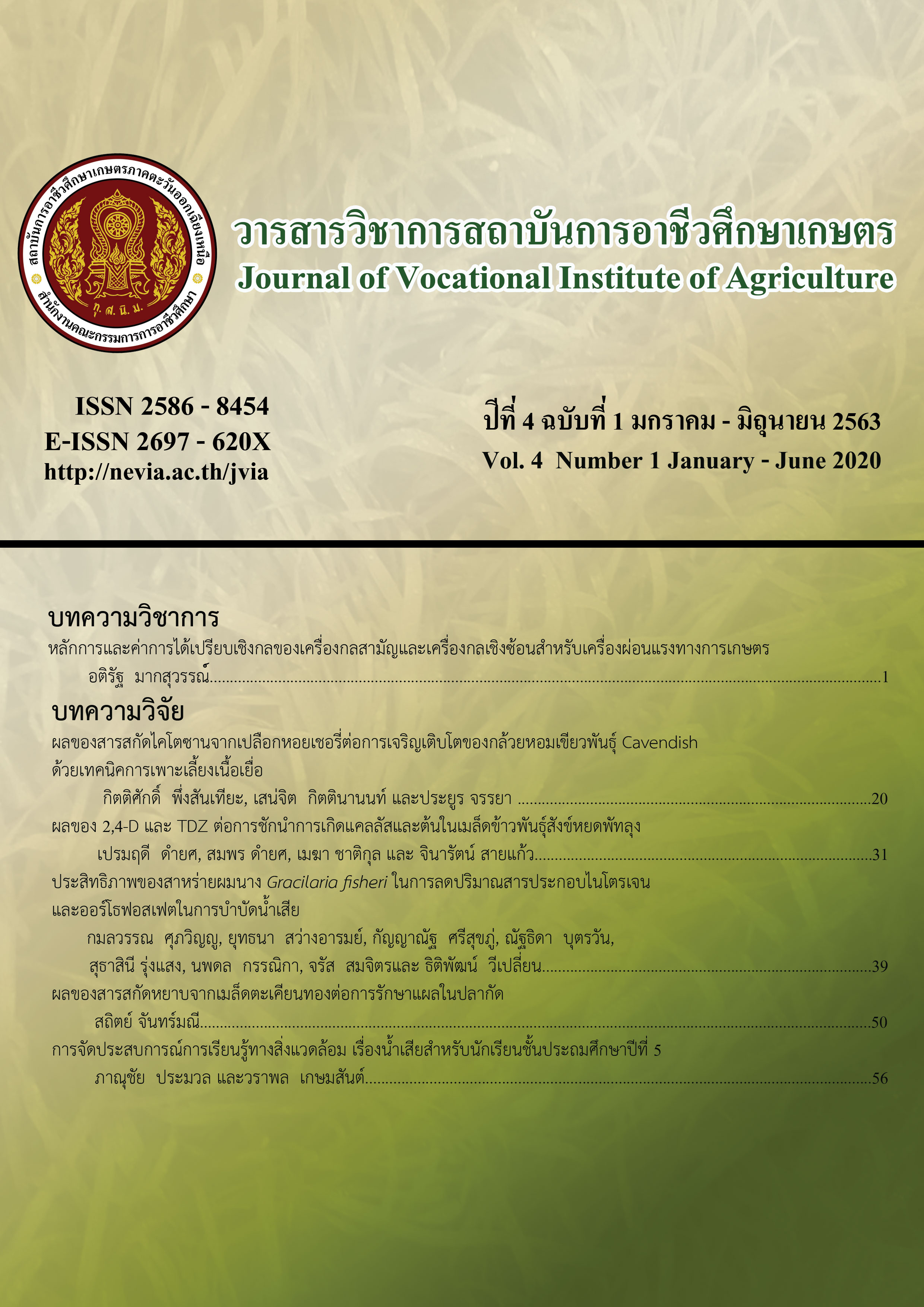Efficiency of Gracilaria fisheri to reducing the nitrogen compounds and orthophosphates for water treatment
Main Article Content
Abstract
Study on the efficiency of Gracilaria fisheri to reducing the ammonia, nitrite, nitrate and and orthophosphates contents from synthetic water. Including 4 experiments; 1) effect of Gracilaria fisheri to reducing ammonia content in water, 2) effect of Gracilaria fisheri to reducing nitrite content in water, 3) effect of Gracilaria fisheri to reducing nitrate content in water and 4) the effect of Gracilaria fisheri to reducing the orthophosphate content in water. In each experiment, there were 4 different amounts of Gracilaria fisheri with triplicate; 0 g/L (T1 or control group), 1 g/L (T2), 5 g/L (T3), and 10 g/L (T4). The total volume of water for each treatment was 5 L. The experimental period was 28 days or until the content of nitrogen compounds and orthophosphate decreased to 0 mg/L. At the end of the experiment, changes in the fresh weights of Gracilaria fisheri were determined.
The result of experiment 1 showed that 10 g/L of Gracilaria fisheri could reduce 100% of ammonia content at 4 days after treatment (DAT). In experiment 2, using 10 g/L of Gracilaria fisheri could reduce 100% of nitrite at 7 DAT. Both experiments showed that T4 treatment was no significant effective than T3 treatment (P>0.05). Experiment 3 found that 10 g/L of Gracilaria fisheri could reduce 100% of nitrate by at 13 DAT and showed that T4 treatment was significantly effective than other treatments (P<0.05). However, the result of experiment 4 showed that 10 g/L of Gracilaria fisheri could reduce the orthophosphate content better than other treatments but not significantly different (P>0.05). The content of orthophosphate in all treatments was not different (P>0.05). The fresh weights of Gracilaria fisheri in each experiment of T4 were increased by 12.7±1.2%, 11.3±1.2%, 21.3±4.2%, and 31.3±7.6%, respectively.
Hence, using 5 g/L of Gracilaria fisheri had higher efficiency in reducing the content of ammonia and nitrite in the water and using 10 g/L of Gracilaria fisheri had higher efficiency in reducing the content of nitrate in water.
Article Details
The content and information in articles published in the Journal of Vocational Education in Agriculture are the opinions and responsibility of the article's author. The journal editors do not need to agree or share any responsibility.
Articles, information, content, etc. that are published in the Journal of Vocational Education in Agriculture are copyrighted by the Journal of Vocational Education in Agriculture. If any person or organization wishes to publish all or any part of it or to do anything. Only prior written permission from the Journal of Vocational Education in Agriculture is required.
References
กมลวรรณ ศุภวิญญู ยุทธนา สว่างอารมย์ ณิชาพล แก้วชฎา. (2557). การเสริมโพแทสเซียม แมกนีเซียม ในระบบการอนุบาลกุ้งก้ามกรามที่ลดการปล่อยของเสียด้วยน้ำหมุนเวียน (รายงานผลการวิจัย). ชุมพร: มหาวิทยาลัยแม่โจ้.
กมลวรรณ ศุภวิญญู, ส่งศรี มหาสวัสดิ์, สมหวัง พิมลบุตร, และสุนทราภรณ์ ลิ่มสกุล. (2549). ปริมาณแร่ธาตุบางชนิดในกุ้งก้ามกรามวัยอ่อนที่อนุบาลด้วยระบบกรองน้ำหมุนเวียน. ใน การประชุมทางวิชาการของมหาวิทยาลัยเกษตรศาสตร์ ครั้งที่ 44, กรุงเทพฯ, 135-143.
ชีวิน อรรถสาสน์. (2558) การใช้สาหร่ายสีเขียวแกมน้ำเงิน (Oscillatoria sp.) ในการบำบัดน้ำทิ้งจากการเลี้ยงปลานิลในระบบน้ำหมุนเวียน.กรุงเทพฯ: สถาบันพัฒนาและฝึกอบรมโรงงานต้นแบบ มหาวิทยาลัยเทคโนโลยีพระจอมเกล้าธนบุรี.
ชูสินธ์ ชนะสิทธิ์, สมหมาย เชี่ยววารีสัจจะ, และอุดม พืชน์ไพบูลย์. (2550). การเลี้ยงหอยเป๋าฮื้อระยะวัยรุ่นโดยใช้ระบบน้ำหมุนเวียน. ใน สัมมนาวิชาการด้านการเพาะเลี้ยงสัตว์น้ำชายฝั่ง, กรุงเทพฯ, 10-13.
ธวัช ศรีวีระชัย. (2548) การเลี้ยงสาหร่ายเขากวาง Gracilaria edulis (Gmelin) Silva และ สาหร่ายมงกุฎหนาม Acanthophora spicifera (Vahl) Borgesen ในบ่อบำบัดน้ำทิ้ง. เอกสารวิชาการฉบับที่ 17/2548 กรุงเทพฯ: กระทรวงเกษตรและสหกรณ์ กรมประมง สำนักวิจัยและพัฒนาประมงชายฝั่ง.
บุญส่ง สิริกุล และวิวรรธน์ สิงห์ทวีศักดิ์. (2531). การเพาะเลี้ยงสาหร่ายทะเลสีแดง Polycavernosa fastigiata และ Gracilaria tenuistipitata ในบ่อเลี้ยงกุ้ง ใน การสัมมนาวิชาการประจำปี 2531 (น.41). กรุงเทพฯ: กรมประมง.
ปวีณา ทวีกิจการ. (2546). การกำจัดสารอินทรีย์และโลหะหนักจากน้ำเสียโดยใช้สาหร่ายขนาดเล็ก (Oscillatoria sp., Microcystis sp.). (รายงานวิจัย). กรุงเทพฯ: สถาบันเทคโนโลยีพระจอมเกล้าเจ้าคุณทหารลาดกระบัง.
มั่นสิน ตัณฑุลเวศน์ และไพพรรณ พรประภา. (2540). การจัดการคุณภาพน้ำและการบำบัดน้ำเสียในบ่อเลี้ยงปลา และสัตว์น้ำอื่นๆ : เล่ม 1 การจัดการคุณภาพน้ำ. พิมพ์ครั้งที่ 4. กรุงเทพฯ: โรงพิมพ์แห่งจุฬาลงกรณ์มหาวิทยาลัย.
วิวรรธน์ สิงห์ทวีศักดิ์ และทรงสิทธิ์ ลิ้มสกุล. (2543). การเลี้ยงสาหร่ายผมนาง Gracilaria fisheri (Xia&Abbott) Abott, Zhang&Xia, ร่วมกับปลากะพงขาว Lates calcarifer Bloch, ในบ่อดิน. เอกสารวิชาการฉบับที่ 14/2543. ศูนย์พัฒนาการเพาะเลี้ยงสัตว์น้ำชายฝั่งจันทบุรี กิงเพาะเลี้ยงสัตว์น้ำชายฝั่ง กรมประมง. 15 น.
ศิราภรณ์ ชื่นบาล. (2553). การบำบัดน้ำทิ้งจากฟาร์มเพาะเลี้ยงสัตว์น้ำด้วยพืชน้ำและสาหร่าย (รายงานการวิจัย). เชียงใหม่: มหาวิทยาลัยแม่โจ้.
อัจฉรียา แก้วมีศรี. (2543). การบำบัดน้ำเสียจากการเลี้ยงกุ้งกุลาดำ, Penaeus monodon Fabricius, โดยใช้สาหร่ายผมนาง Gracilaria fisheri (Xia&abbott) Abott, Zhang&Xia. ปริญญานิพนธ์ วท.ม. (เทคโนโลยีการบริหารสิ่งแวดล้อม). นครปฐม: บัณฑิตวิทยาลัย มหาวิทยาลัยมหิดล.
Hu M. H. Ao Y. S. Yang X. E. and Li T. Q. (2008). Treating eutrophic water for nutrient reduction using an aquatic macrophyte (Ipomoea quatic Forsskal) in a deep flow technique system. Agricultural Water Management, 95 (5), 607-615.
Friedlander, M., & van Rijn, J. (2018). Ammonia and CO2 enrichment of a Gracilaria cultivation pond through biofiltration of organic waste. Aquaculture, 482, 45-48.
Tanner, C. C., Sukias, J.P.S., Upsdell, M.P., (1999). Substratum phosphorus accumulation during maturation of gravel-bed constructed wetlands. Water Science Technology, 40, 147-154.
Wongkiew, S., Hu, Z., Chandran, K., Lee, J. W., and Khanal, S. K. (2017). Nitrogen transformations in aquaponic systems: A review. Aquacultural Engineering, 76, 9-19.

